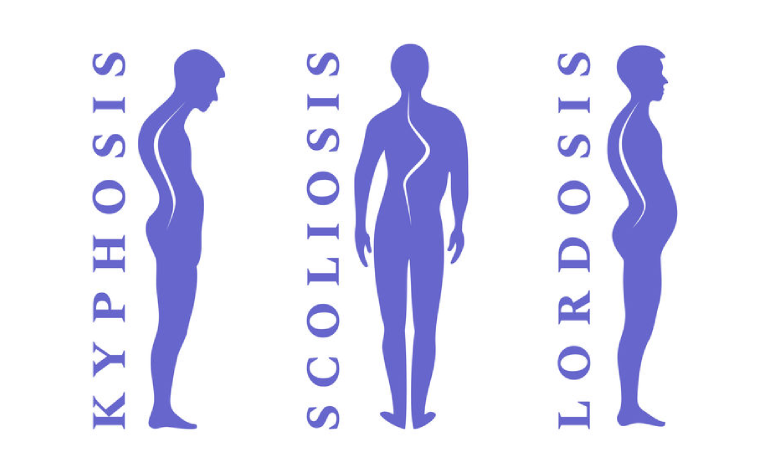TYPES OF SPINAL DEFORMITIES
Spinal deformities can manifest in different ways, each with its own characteristic features. Some common types of spinal deformities include:
Scoliosis:
Scoliosis is characterized by an abnormal sideways curvature of the spine. It often develops during adolescence and can range from mild to severe, causing postural imbalances and potential lung or heart complications.
Kyphosis:
Kyphosis is an excessive forward curvature of the upper spine, leading to a hunched or rounded appearance of the back. It can be caused by factors such as poor posture, osteoporosis, or congenital abnormalities.
Lordosis:
Lordosis refers to an exaggerated inward curvature of the lower spine, commonly seen in the lumbar region. It can result from various factors, including obesity, muscle imbalances, or certain medical conditions.
Spondylolisthesis:
Spondylolisthesis occurs when a vertebra slips forward or backward, causing misalignment of the spinal column. This condition can be congenital or acquired due to degenerative changes or trauma.
CAUSES AND RISK FACTORS
Spinal deformities can have multiple underlying causes and risk factors. Some common factors contributing to spinal deformities include:
Congenital Factors:
Certain spinal deformities are present at birth due to abnormal spinal development in the womb.
Degenerative Changes:
Age-related wear and tear, arthritis, or disc degeneration can contribute to spinal deformities such as kyphosis or spondylolisthesis.
Poor Posture and Body Mechanics:
Maintaining incorrect posture or engaging in repetitive movements that strain the spine can gradually lead to spinal deformities.
Trauma & Injury:
Accidents, fractures, or spinal injuries can disrupt the natural alignment of the spine, resulting in deformities.
TREATMENT OPTIONS:
The treatment of spinal deformities depends on various factors, including the type and severity of the condition, the patient's age, overall health, and symptoms. Here are some common treatment options:
Non Surgical Approaches:
Non-surgical treatments aim to manage symptoms, improve function, and slow down the progression of spinal deformities. These may include physical therapy, exercises to strengthen supporting muscles, pain management strategies, bracing (especially for scoliosis in growing children), and postural training.
Surgical Interventions:
Surgery may be recommended for moderate to severe spinal deformities or when conservative treatments fail to provide adequate relief. The surgical procedures can involve realigning and stabilizing the spine, decompressing nerves, and correcting the curvature. Common surgical techniques include spinal fusion, spinal instrumentation (such as rods, screws, or wires), and osteotomy (removal or reshaping of bone).
Minimally invasive techniques:
Minimally invasive techniques have gained prominence in the treatment of certain spinal deformities. These procedures involve smaller incisions, specialized instruments, and advanced imaging technology, resulting in reduced tissue damage, shorter recovery times, and improved cosmetic outcomes. Minimally invasive surgeries may include endoscopic spine surgery, microdiscectomy, or percutaneous fixation.
Spinal deformities can significantly impact an individual's well-being, but with advancements in diagnostics and treatment options, managing these conditions has improved. Understanding the different types of spinal deformities, their causes, and available treatment approaches is essential for patients and healthcare professionals alike. By exploring non-surgical interventions, surgical options, and the role of ongoing monitoring and rehabilitation, individuals with spinal deformities can make informed decisions about their care. If you or a loved one is affected by a spinal deformity, consulting with a qualified healthcare provider specializing in spine conditions will help determine the most suitable treatment plan for your specific needs.

